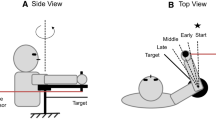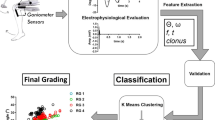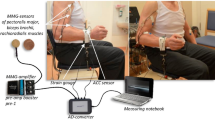Abstract
Reflex sympathetic dystrophy (RSD) is a syndrome that frequently follows an injury and is characterized by sensory, autonomic and motor features of the affected extremities. One of the more common motor features of RSD is tonic dystonia, which is caused by impairment of inhibitory interneuronal spinal circuits. In this study the circuits that modulate the gain of proprioceptive reflexes of the shoulder musculature are quantitatively assessed in 19 RSD patients, 9 of whom presented with dystonia. The proprioceptive reflexes are quantified by applying two types of force disturbances: (1) disturbances with a fixed low frequency and a variable bandwidth and (2) disturbances with a small bandwidth around a prescribed centre frequency. Compared to controls, patients have lower reflex gains for velocity feedback in response to the disturbances around a prescribed centre frequency. Additionally, patients with dystonia lack the ability to generate negative reflex gains for position feedback, for these same disturbances. Proprioceptive reflexes to the disturbances with a fixed low frequency and variable bandwidth present no difference between patients and controls. Although dystonia in the RSD patients was limited to the distal musculature, the results suggest involvement of interneuronal circuits that mediate postsynaptic inhibition of the motoneurons of the proximal musculature.



Similar content being viewed by others
References
Amadio PC, Mackinnon SE, Merritt WH, Brody GS, Terzis JK (1991) Reflex sympathetic dystrophy syndrome: consensus report of an ad hoc committee of the American Association for Hand Surgery on the definition of reflex sympathetic dystrophy syndrome. Plast Reconstr Surg 87:371–375
Bennett DJ, De Serres SJ, Stein RB (1996) Gain of the triceps surae stretch reflex in decerebrate and spinal cats during postural and locomotor activities. J Physiol 496:837–850
Bhatia KP, Bhatt MH, Marsden CD (1993) The causalgia-dystonia syndrome. Brain 116:843–851
De Vlugt E, Van der Helm FCT, Schouten AC, Brouwn GG (2001) Analysis of the reflexive feedback control loop during posture maintenance. Biol Cybern 84:133–141
Doemges F, Rack PMH (1992a) Changes in the stretch reflex of the human first dorsal interosseous muscle during different tasks. J Physiol 447:563–573
Doemges F, Rack PMH (1992b) Task-dependent changes in the response of human wrist joints to mechanical disturbance. J Physiol 447:575–585
Illert M, Kummel H, Scott JJ (1996) Beta innervation and recurrent inhibition: a hypothesis for manipulatory and postural control. Pflugers Arch 432:R61–R67
Jankowska E (1992) Interneurol relay in spinal pathways from proprioceptors. Prog Neurobiol 38:335–378
Jenkins GM, Watts DG (1968) Spectral analysis and its applications. Holden-Day, San Francisco
Katz R, Mazzocchio R, Penicaud A, Rossi A (1993) Distribution of recurrent inhibition in the human upper limb. Acta Physiol Scand 149:183–198
Paice E (1995) Reflex sympathetic dystrophy. BMJ 310:1645–1648
Ribbers G, Geurts ACH, Mulder T (1995) The reflex sympathetic dystrophy syndrome: a review with special reference to chronic pain and motor impairments. Int J Rehabil Res 18:277–295
Schouten AC, De Vlugt E, Van der Helm FCT, Brouwn GG (2001) Optimal posture control of a musculo-skeletal arm model. Biol Cybern 84:143–152
Schwartzman RJ, Kerrigan J (1990) The movement disorder of reflex sympathetic dystrophy. Neurology 40:57–61
Sinkjaer T, Hayashi R (1989) Regulation of wrist stiffness by the stretch reflex. J Biomech 22:1133–1140
Stein RB, Capaday C (1988) The modulation of human reflexes during functional motor tasks. Trend Neurosci 11:328–332
Van der Helm FCT, Schouten AC, De Vlugt E, Brouwn GG (2002) Identification of intrinsic and reflexive components of human arm dynamics during postural control. J Neurosci Methods 119:1–14
Van Hilten BJ, Van de Beek WJT, Hoff JI, Voormolen JH, Delhaas EM (2000) Intrathecal baclofen for the treatment of dystonia in patients with reflex sympathetic dystrophy. N Engl J Med 343:625–630
Van Hilten JJ, van de Beek WJT, Vein AA, van Dijk JG, Middelkoop HAM (2001) Clinical aspects of multifocal or generalized tonic dystonia in reflex sympathetic dystrophy. Neurology 56:1762–1765
Acknowledgements.
This research was supported financially by the Netherlands Organization for Scientific Research (NWO).
Author information
Authors and Affiliations
Corresponding author
Appendices
Appendix 1: Spectral estimators
The time signals were sampled at 500 Hz for 40 s, giving 20,000 samples. To remove the transient response, only the last 16,384 samples (214 ≈33 s) from the measured time signals were used for further processing. The position, force, and disturbance signals (x h (t), f h (t), d(t)) were Fourier transformed (via Fast Fourier transform, FFT) and used to estimate the cross-spectral densities (CSDs).
in which \( \hat S_{df} \left( f \right) \) and \( \hat S_{dx} \left( f \right) \) denote the estimated CSDs, the asterisk denotes the complex conjugate. X h(f), F h(f) and D(f) denote the Fourier transforms of x h(t), f h(t) and d(t) respectively. The CSDs are averaged over eight frequency bands to improve the estimate and to reduce the variance of the estimator (Jenkins and Watts 1968). As a result the frequency resolution drops to \( {8 \over {32,678}} \approx 0.24\;{\rm Hz} \).
Figure 4 gives a closed-loop blockscheme of human posture control with force disturbances. In this study the manipulator can be described as a small (virtual) mass of 0.6 kg (the viscosity and stiffness of the manipulator are negligible). From the appropriate CSDs the human arm impedance and squared coherence function are estimated:
in which C(f) is the estimated impedance and Γ2(f) the squared coherence function.
Blockscheme of human posture control expressed in the frequency domain. C(f) transfer function of arm dynamics, P(f) transfer function of manipulator dynamics, D(f) external force disturbance, F h (f) hand reaction force, X h (f) hand position (coincides with the manipulator handle); N(f) model remnant; X d =0 reference position. The arm dynamics (dotted box) are described by the linear transfer function, C(f), together with the remnant N(f), which is uncorrelated with D(f)
Appendix 2: Arm model
The arm model (excluding the hand; dashed box in Fig. 5) is represented as a causal system with force as input and position as output. The interaction force, modelled as the hand force (F h (s)), that drives both the arm and manipulator results from the hand dynamics (H h (s)) and the difference between the handle position (X h (s)) and arm position (X a (s)):
The Laplace operator, s, equals λ+j2πf in which λ=0 because the initial transient response is not of interest in this study.
The linear arm model from which the transfer function C mod (s) is derived; see Eqs. 6–10. This model represents the measured transfer function, C(f), given in Fig. 4
The hand force minus the reflexive force (minus because of the negative feedback loop) inputs the intrinsic model. The intrinsic dynamics (H i (s)) comprise the passive dynamics and the active muscle dynamics (as a result of coactivation):
The force as a result of reflexive feedback is given by:
where H r (s) represents the length and velocity feedback and H act (s) the activation dynamics. The time delay (T d ) and the activation time constant (τ a ) are fixed to 25 and 30 ms respectively.
The arm model excluding hand dynamics (dashed box in Fig. 5) is given by:
Combining Eqs. 6–9 gives the complete model including the hand dynamics:
Appendix 3: Parameter estimation
To quantify the reflexive and intrinsic parameters, the model (Eq. 10) is fitted on the measured impedance (Eq. 4). The following criterion function is used to estimate the model parameters:
where k indexes the frequency vector.
Rights and permissions
About this article
Cite this article
Schouten, A.C., Van de Beek, W.J.T., Van Hilten, J.J. et al. Proprioceptive reflexes in patients with reflex sympathetic dystrophy. Exp Brain Res 151, 1–8 (2003). https://doi.org/10.1007/s00221-003-1420-x
Received:
Accepted:
Published:
Issue Date:
DOI: https://doi.org/10.1007/s00221-003-1420-x






